Climate Change, Flood Control, and Drought – The Problem Persists and can be overwhelming.

This photo, from a November 15 Guardian Newspaper article by Rahul Raina (‘In Delhi I can see the climate catastrophe unfolding before my eyes’ | Delhi | The Guardian), is of villagers at a nearly dried up well in Samba District (near Jammu – North West India). It also shows a lot more, more than most casual observers see. The middle ground terraces continue to erode (look carefully at the tree roots exposed by erosion). These same terraces are outward sloping, as are hundreds of thousands of similar terraces in south Asia and Africa. They all shed precious rainwater, and under extreme rainfall conditions shed it fast, and in large volumes. When combined with outflows from many similar areas they contribute to major downstream flooding such as that occurred recently in Pakistan (Samba, although in India, is in the Indus River Basin).
I spend a good bit of time on Google Earth plotting known vetiver applications. In the course of this one is struck by the literally millions of hectares of unprotected land that contributes to storm water runoff and flooding. These same hectares have been losing their tree cover and topsoil at alarming rates. It is an overwhelming problem that will take a massive and concerted effort to correct, one that has to be done by community effort, supported by knowledge transfer and incentive funding. The only country that I know of, that has attempted this at scale, with some success, is China.
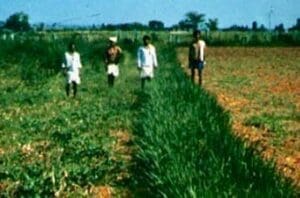
This need not be the case, particularly if eco-engineering, green, solutions are employed. Growing vetiver hedgerows on these terrace edges would provide a good solution. A solution using vetiver has been around for a long time now! Nearly 40 years ago – yes, forty years ago, John Greenfield and I, together with some of the most senior officials from the Government of India and four southern Indian states, had a field day at Gundlupet (Mysore District – annual rainfall 600 mm). There, we met farmers who had for decades used (locally developed knowledge) vetiver hedgerows as field boundaries, for soil and water

conservation and for forage. They knew and understood the benefits, including the fact that their well water levels were much higher than those in villages where vetiver was not used. We were told that the research staff knew better (they didn’t!). These same farmers told us that their crops were not affected by the ongoing drought at that time because of the vetiver induced reduction in rainfall run off and improved soil moisture resulting in delayed crop wilting point by 10 days or more. The vetiver hedge deconcentrated water flows, spreading it out and improving infiltration. Those same hedgerow deep and massive root system enhanced the rhizosphere and activity within it. At about that time ICRISAT, located at Hyderabad (India), carried out some experiments relating to extreme rainfall events and the impact of vetiver hedgerows on the storm hydrograph, comparing vetiver with bare ground (control), stone bunds, and lemon grass on two shallow different slopes. Vetiver grass not only had the longest delay in runoff, but also had the slowest rate – and this for only a 6 month old hedge.. Imagine the effect of a mature fully formed hedge. Back to the field day – the policy makers knew the farmers were right in their use of vetiver, but the engineer/structures dominated Conservation Department held sway – the intervening 40 years between then and COP27 have been virtually wasted! The norm is still outward sloping terraces, and more recently massive contour trenching, both costly in land and labor. Note the trenches may trap water but do not provide any of the additional benefits of biological solutions. In Ethiopia multiple research findings back the use of vetiver as a preferred conservation measure, and many hedgerows have been planted on the edge of preexisting outward sloping terraces resulting in significant reductions in soil and water loss, and groundwater recharge that has positive impact on adjacent wetlands and associated water tables.
Back to Rahul Raina’s article – industrial nations have a lot to answer for in climate change damage, but post-colonial policies by Global South nations have also been neglectful, as in the neglect or the promotion of poor decisions in mitigating soil and water losses and associated flooding, often wedded to policies that benefit the officials and not the end user.


The Vetiver System – A toolkit in support of community-led, climate change adaptation.
Jim Smyle (TVNI President) was, in October, invited as a keynote speaker to ECHO’s annual conference attended by some 200 people of which half were from the field. ECHO operates in the US, Africa and Asia with a mission to introduce sustainable plants, techniques, and technologies to farmers around the world who are struggling to feed their families. It provides training and resources that empower small-scale farming families to thrive. About 30% of ECHO’s field staff are introducing the Vetiver System to farmers and they would like to work with vetiver users – so those of you who want to see the acceleration of the technology in your country take the opportunity to meet and discuss with ECHO folks. Jim’s presentation provides an up-to-date picture of vetiver and its opportunities as a tool kit for communities in this challenging time of climate change. You can download the presentation here. I think that you could find it useful when discussing vetiver adoption with local leaders and farmers.
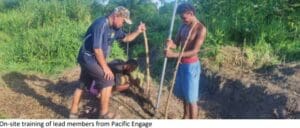
Scaling up Ecosystem-based Adaption in Guadalcanal, Solomon Islands — Mid Cycle Project Activity Report.
“Participants are literally seeing conditions of their problems improving in comparison to conditions prior to installation of VGT”.
The Vetiver Network International and Pacific Engage (local NGO) were engaged to implement a project funded by the South Pacific Community (SPC) under contract reference number GA 21/003. The project is a one year program to build capacity among residents of Honiara and the communities in Guadalcanal within their respective catchment areas to utilize Vetiver Grass Technology (VGT) for a wide range of community-led applications that both mitigate serious soil and water-related problems and enhance local communities’ resilience to face climate changes’ impacts. This project develops the knowledge capital by providing training, technical and logistical support required to expand the use of VGT for a broad range of climate change adaptation/ environmental management needs. The report by key players, Paul Oana (PE) and Robinson Vanoh (TVNI) should be useful for designing other community based projects. The following are some observations and outcomes from the pilot VGT established sites:
- Improvement in ground conditions (surface water runoff). Slope area was an all year round wet area, noted that it has improved with no surface water runoff.
- Improvement in ground condition and crop yield at Milk Fish Bay resort. Before Vetiver was planted, participant advised that sweet potato had very low yield, after planting it increased in yield and size.
- No more smell and improved conditions at the sewage discharge outlet since Vetiver was planted.
- Improve ground water taste at Tavanihu where Vetiver was planted to protect underground water stream.
- Effective control of soil erosion at Ruarua where sediments are trapped on land rather than washed into the sea.
- Effective management of nursery and planted sites by participants. Family units taking ownership of respective sites. Family ownership is highly recommended for future project upscale.
- Improve ground conditions on slopes where Vetiver was planted with no erosional activities.
- Vetiver planted under shade trees not growing well at Milk Fish Bay Resort and Ruarua.
- Plant spacing between the Vetiver slips at 30cm on all sites (too far apart). Recommended spacing between plants is 12-15cm. Plant new slips in between them again.
- Nursery establishment on slopes is not recommended.
Vetiver had been introduced to the Solomon Islands some years ago, but few people knew why! We believe it was planted mainly as a roadside wall against dust kicked up by road traffic in urban areas. No one was told about vetiver’s other benefits – – this project provides practical knowledge, demonstrating VGT’s multiple applications, delivered by vetiver expertise who knows what he is doing ( I am afraid a lot of experts do not!), together with adequate supplies of vetiver plant material, appear to be key factors enabling VGT scale up at community level.
Vetiver and rainfall runoff reduction – “it’s phenomenal ability for ground water recharge”.
K.Vinod Kumar (2011): Quote “ While vetiver hedgerows have demonstrated a marked capacity for recharge of ground water, the explanation is not satisfactory. Current viewpoint is that the shoot part of the vetiver hedgerow slows down the surface flow, filters out the sediments, and diverts the flow sideways. These effects may explain part of the increased water recharge. A complete explanation of the recharge has to consider and model the subsurface architecture of vetiver, its deep dense vertical root system. ……. While vetiver roots may age and disintegrate to form vertical macro-pores, it is the surface of the roots themselves that provides a high Facial Area Density for regions under a vetiver hedgerow. The Facial Area Density can be related to the Root Length Density. For vetiver this surface is vertical and long. Hence the phenomenal capacity of vetiver hedgerows to increase ground water recharge can be attributed to the high vertical surface area provided by the vetiver roots for film flow. The shoot parts of the plant, start the film flow from the surface water and the myriad long vertical roots of vetiver, connected to the shoot, seamlessly transfer the water as surface film at a fast rate to the deeper regions. The film flow over the vetiver roots will be modeled qualitatively and computationally……” Supporting documents: Modeling Ground Water Recharge Under Vetiver Hedgerows – Paper Presentation.
Vinod Kumar’s modelling and conclusions help us understand the phenomenal ability for ground water recharge. Wherever I have travelled vetiver’s ability to reduce rainfall runoff and recharge groundwater is evident, and it appears to do it better, in much less time, and at far less cost than most other conservation techniques. It also provides guaranteed bi products that most other methods do not.
I addressed some of these points together in a 2021 post that I suspect most readers did not see … Flood control, groundwater recharge and erosion control. 2022 has been another year of drought and flood, retreating water tables (less water for irrigation, drying up rivers etc.) and damage to crops and property. To mitigate these problems (and they are not going to go away in a hurry) we have to find the most effective, least cost, easy to apply technologies and upscale them at a very wide and accelerated scale. For the hot tropical parts of the world Vetiver Grass Technology is a very good tool to do this as it meets nearly all of the criteria, and has a proven and researched record over nearly 40 years. Most farmers like the technology when correctly trained and introduced to it.
Gully Rehabilitation — Fiji, Zimbabwe, Kenya
In the mid 1980s I asked John Greenfield to go back to Fiji and find out what had happened to the large vetiver planting programs that he was involved with in the 1950’s. Photo 6 demonstrates its use for gully control on a Fijian hill side 30 years after establishment. Graham Dabbs shared these photos (7 and 8) of a major gully rehab project in Zimbabwe.
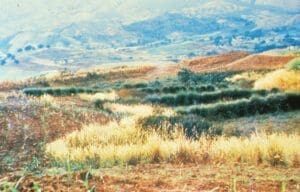
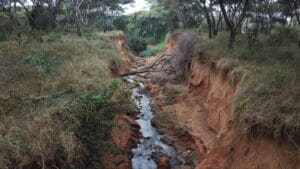
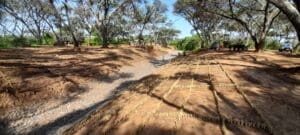
In Kenya (70 years after Greenfield’s Fijian planting) Simon Teimuge of “Vetiver in Kenya” (a Whatsapp group) shared some photos showing how he has used vetiver to prevent treat a small gully on his farm (photos 9-12 below). To assure that vetiver slips would not be washed out with the first rains they were planted in “earth bags”. With the rains there was a rapid build up of silt behind the established hedge. Bananas were planted in the reclaimed gully.
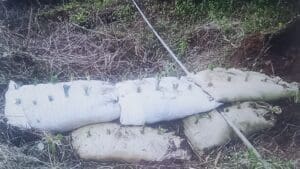
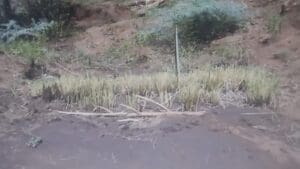
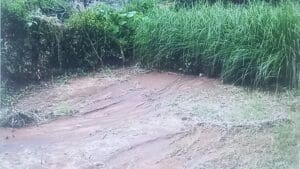

Dam spillway protection in Zimbabwe.
In 1997 I visited Jano Labat, a sugar farmer in Zimbabwe, who had introduced Vetiver from his native country, Mauritius. At that time Jano had just planted some dam spillways to vetiver. 25 years later Graham Dabbs, who also farms in the area, visited the sites in October and wrote to say that the spillways were stable and that most of the vetiver had been shaded out by native shrubs and trees – not unexpected when no maintenance had been undertaken. Photos are available at iNaturalist at: Site 1 and Site 2.
Slope stabilization – Development of Vetiver Technical Standards.
A group chaired by Dr. Mohammad Shariful Islam (Bangladesh University of Engineering and Technology — BUET) is currently developing a set of standards that can be used for design work for slope stabilization. There is a focus on correct design, quality application, and follow up maintenance. We hope this will be completed in 2023. These standards should play an important role as the applications of vetiver for slope stabilization for civil works expands, and essential when the client requires designs and specifications that meet engineering requirements. Poor design and application must be rejected. We see examples everyday of good quality vetiver
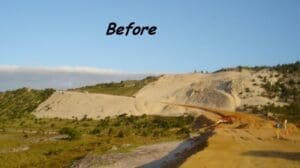
applications, as well as just plain awful ones – the latter do not
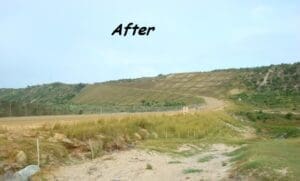
help the expansion of the technology and waste a lot of money. Here are examples of good and bad applications on sandy slopes. The good from Madagascar where supervision, design, application and quality plants were the norm. The bad from India where sadly nothing was right.
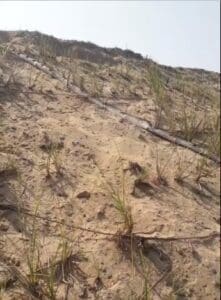
The Indian application failed, as in many community projects, because of poor technical application, poor community knowledge transfer, and poor quality unculled plant material. Here is a quote from the field “The plantation and the spaces in between tells more than it shows. The story is excruciatingly painful …. I consider any restoration work starts from the mind. This has got to do with modalities, processes, ownership and obviously teamwork. And lot of patience when it comes to vetiver. There were plants that were eaten by goats specially the villagers who got the forage free of cost. But I am not angry for them, they are extremely poor. We did provide the manure, specially cow dung, for the plants, but it was never used. The plants are all DEAD according to the real stakeholders, so they don’t have a STAKE. The plant source points were from those farmers who cultivate vetiver (for oil?) for living. With this explanation highlights a vicious cycle that we are a part of in this region and vetiver can give us fair chance to come out of if we correct some of our pitfalls. Yes, the work is continuing, and we are reevaluating the implementation model.”
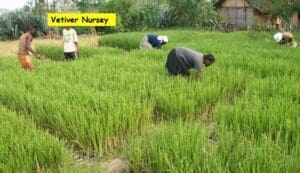
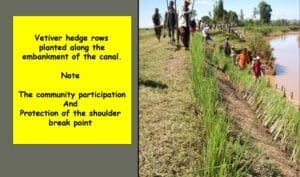
Well trained and knowledgeable communities, even if very poor are quite capable of producing good quality plant material and planting it correctly as shown in these two images from Madagascar.
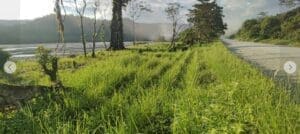
Papua New Guinea (PNG) embracing the Vetiver System.
What a difference one man with commitment, knowledge and hands on experience can make! In PNG ,this man is Robinson Vanoh. He owns and operates Eagle Vetiver, is a TVNI Board Director, and has voluntarily provided a lot of his time supporting VS introduction to other South Pacific Islands. In 2018 Robinson was contracted to establish a vetiver trial at the PNG OK TEDI copper mine, a major polluter of downstream rivers. The trial was a success and VS is now included in the mines work plan for all its erodible sites and for the 150 km road corridors.
The National Works and Highways Department in PNG is also considering including VS into its Specifications and Requirements. Following an upcoming presentation by Robinson it is likely that VS will be applied to all new roads constructed under the CONNECT PNG Program
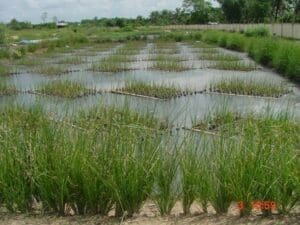
Floating Wetland Treatment …
Vetiver has been quite widely used for Floating Wetland Treatment (FWT) of contaminated water bodies. Results show visually as cleaner, clearer water. In China some large scale applications have been used for the successful cleanup of fish ponds and fish pond effluent lagoons. Recently an interesting piece of research by Álvarez-Ascencio Alberto,López-Martínez Sugey,Rodríguez-Luna Ana R.,López-Hernández Eduardo S.,Morales-Bautista Carlos M.,Hernández-Núñez Emanuel has confirmed the efficiency of vetiver for clean up of a arrange of heavy metals in landfill leachates. The abstract for the paper, “Analysis of Chrysopogon zizanioides used as floating treatment wetlands in the removal of heavy metals present in leachate” follows:
“The objective of this study was to evaluate the potential of Chrysopogon zizanioides using the floating wetland treatment (FWT) technique in the removal of As, Cd, Cr, Cu, Pb, Zn, Fe, and Hg from three different concentrations of landfill leachate (100% crude leachate [L100], 75% leachate + 25% tap water [L75], and 50% leachate + 50% tap water [L50]) for a period of 60 days. The concentration of heavy metals in leachate and C. zizanioides was analyzed by inductively coupled plasma optical emission spectrometry. The results show that heavy metal concentrations decrease significantly (p < 0.05) in vegetation treatments. Removal efficiency was higher in the L100 leachate with 100%, 58.1%, 33.4%, 67.8%, 58.3%, 29.4%, 69.2%, and 67.2% for As, Cd, Cr, Cu, Fe, Hg, Pb, and Zn, respectively. This study demonstrates the efficiency of removing heavy metals from landfill leachate using the FWT technique.”
All over south and east Asia are small water bodies (farm and community ponds, temple tanks, and effluent lagoons) that are heavily contaminated with heavy metals, high levels of nitrates, phosphates and BODs, and pesticides of various sorts. Vetiver FWT can be very effective in cleaning these waters. The trick for success is preparing effective and robust pontoons and quality and properly prepared vetiver plants (these need to be about 3 months old and well rooted) …. you need a lot of them … and they need to be MAINTAINED AND MANAGED. In most cases, failure can be traced to poor design, plant material and management. Paul Truong put together this presentation that should be helpful to those who want to use the FWT technology.
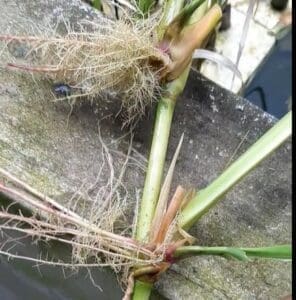
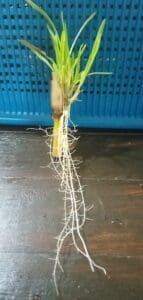
Vetiver Propagation from Stem Cuttings —
Mohammad Ariffin Khan of Malaysia has been busy sharing his propagation techniques on Facebook. They include propagation from stem cuttings and creation of vetiver strips using old gutters as containers. If you have a “green thumb” and have mother plants that have flower stems (not all vetiver have them) he reckons produce 3,000 vetiver planting slips per month from 10-15 mother plants. (his video provides a good explanation). Thank you Sami for some useful and practical advice.
Vetiver Grass Handicraft Training.
As mentioned in the October Newsletter there is a demand for handicraft training from many countries in the world. Among other options we are exploring the possibility of online interactive training using a “zoom” type platform.
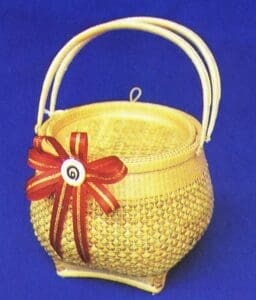
Such training could comprise a series of say, two-hour lessons over a +/- 10 week period. The Thais are looking into this, as is Oswaldo Luque (Venezuela – Oswaldo has been intimately involved with vetiver handicraft over the past 20 years). Of course there are advantages and disadvantages of training on line, but in this case I believe it could work, it would certainly save costs, minimize travel, and allow many more potential handicrafters to become trained. A Facebook poll shows a 77 poll support for training, these respondents know a minimum of 150 more who would like to be trained – just the tip of the iceberg! We will keep you posted on developments.
Identifying and Locating Vetiver grass and its applications.
iNaturalist is the Internet paltform where we are encouraging the “vetiver family” to post the locations of their vetiver applications, along with some photos and description under a “community” project.– named … Vetiver System … Since starting over 400 new entries have been made, some 600 in all. I encourage vetiver users to enter into the spirit of the Vetiver Family and add to the collection. Thank you.
Short Video Competition.
The five judges now have 34 submitted videos and should finish their evaluation by December 15. The judges, Sawanna Pasiri, Pitayakon Limton , Seth Meyes, Paul Zuckerman and Jeremy Berkoff all have wide “development” experience and have followed the development of Vetiver over many years. We can expect a serious evaluation from them. The results for the seven categories will be announced in early January 2023, along with how we will determine the overall winner. We hope to wrap everything up by end January.
The King of Thailand and TVNI Vetiver Awards.
Details of these awards, how to apply for them and submission deadlines can be found on TVNI’s website at: KING OF THAILAND AWARDS (Submission date December 31 2022) TVNI AWARDS (Submission date: April 1 2023). Potential candidates can submit the same paper(s) for both the King’s and TVNI Awards. NOTE the winners of the six KING OF THAILAND AWARDS will in addition to the $2,500 prize will also have their travel costs, accommodation, and meals paid for by the hosts. These are all important awards and standards are high. The awards provide an opportunity to demonstrate your research and development work.